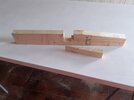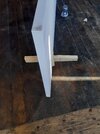The frame is slightly out of square and the existing door was adapted by someone else and fits the frame ok
The term is the door is "shot in" to the opening and there is a general sequence of doing this
Can I use the old door as a template over the new door and use a router ‘copy’ bit?
Frankly, it is more than likely that you'll be on a hiding to nothing if you try this. For starters, assuming that the door edges are square to the faces and that the original door isn't twisted, it would require a 1/2in router and something like a 60mm top bearing trim bit which will follow every minor imperfection in the old door, including the latch recess and the hinge recesses - these cutters are designed to be used with accurately made templates and on deep cuts, like the thickness of a door, will need to be used with extreme caution as it is very easy to overload the cutter and get a dif in or a kick back - so in all probability it will end up looking like a dog's dinner. Trust me, I'm a carpenter, and if someone had come up with a way of doing this which was quick and easy it would have been published decades ago (spoiler alert: nobody has) - after all hand-held routers have only been around for about 110 years...
You are going to have to bite the bullet and learn how to shoot the door in correctly to fit the opening (and not to match the existing door - after all it's the door casing you are trying to match). A few tools make the job a lot easier, though, like a circular saw (to adjust the length, if needed), a home made straight line guide (if using a circular saw), maybe a sliding bevel, a sharp block plane or smoothing plane (another skill to learn - power planers just don't cut it for door hanging), a home made door block (I've made two of those this week for different jobs), chisels for the hinge recesses, etc. It isn't rocket science, but it does take some basic hand tool and measuring skills (which might explain some of the gawdawful workmanship I've seen masquerading as the work of "professional joiners" in recent weeks!).
 Above and Below:A traditional door block used to hold a door in the vertical position whilst the edge is worked on (e.g. lipping, cutting hinge recesses, cutting lock mortises etc). This one was made from an offcut of 4 x 2in CLS
Above and Below:A traditional door block used to hold a door in the vertical position whilst the edge is worked on (e.g. lipping, cutting hinge recesses, cutting lock mortises etc). This one was made from an offcut of 4 x 2in CLS

Sorry if this sounds a bit sour, but door swinging, proper accurate door swinging, just can't be done with short cuts and really isn't that difficult with fairly basic hand tools. Trying to do it with a router is using a sledge hammer to crack a nut



